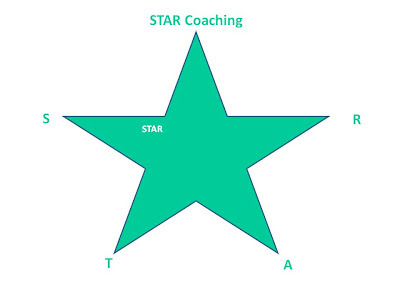 |
| Are You a Star in the Making? |
The model is question based at each stage.
Situation:
(What problem are you trying to solve?)
- What is the specific situation?
- What is causing difficulty?
- What is happening now?
- What are you doing now that is not having a positive impact?
- What thoughts are on your mind?
- What reaction do you want from others?
(What do you want to achieve?)
- What would you like to be different – what are the deadlines?
- What is the desired end state?
- What are the success measures?
- Are they achievable? By when?
(What is your plan?)
- What can you do to change the situation?
- What are the options?
- Are there alternatives?
- Which are most practical?
- How & When?
- How can you ensure you have stakeholder support?
(How do you know if you are successful?)
- What is the desired result?
- How will your review success?
- How do you want to feel as a result?
Using our earlier example of Iam Capable from the “Coaching– How Do you Make it Happen” post
“You manage a large team of mixed capability. One of your team members Iam Capable requests a career development discussion with you. He is worried about the lack of career progression and thinks he has to move teams to achieve the stretch and challenge he seeks.”
Now using the STAR model:
S – The situation is that Iam Capable feels there is a lack of opportunities - his perception is that promotions are awarded to “favourites”. He is sceptical about whether there are going to be career progression opportunities for him and he feels his career is stagnating. He has applied for a promotion before, but not even been selected at the first stage of the process. You know that promotions are competency based.
T - The target is for him to be selected for the initial stage of the promotion process. Ideally this will be in the next round of promotions, which you know to be in 6 months time. You also recognise, that whilst capable, he has skills gaps compared to his peer group. Together you devise a focused skills competency development plan, with the targeted delivery date of 5 months. You discuss with him that these timeframes are a stretch target and that the required full competency development might not be possible in these timeframes. You make him aware of a further round of promotions and reassure him that he is “on your radar”.
A – There are a number of actions you could take to achieve accelerated development – coaching, mentoring, e-learning, classroom training or a blended approach. Alternatively you could move him to another team to ensure he gains the knowledge. Together you evaluate the options. Due to work priorities a team move is not possible. You opt for a mentor who will help him focus on his strengths, give him the confidence he needs and help raise his profile. It’s a partnership approach - Iam Capable (is indeed capable of a promotion!) and he now needs to work with his mentor, driving that relationship, taking the ownership for developing his skills.
R – the review is whether he is successful in progressing to the initial stages of the selection process either in 6 months time or in the following round. The ultimate measure is if he is successful at interview – which will be down to his self confidence and the developmental opportunities he has undertaken. You want to be regarded as a manager who develops their staff and for your areas to be regarded as a placement of choice, due to the career opportunities they afford.
The STAR model is also a tool commonly used by government departments and the public sector for competency based job application processes. For competency based recruitment give thought to how you can demonstrate:
- What was the problem?
- What did you need to do?
- How did you plan?
- What did success look like?




